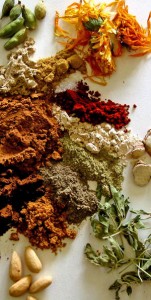About Tibetan herbal medicine
From Tibet, the land of the Himalayas, the roof of the world, comes one of the oldest (and still practised) herbal remedies. A tradition dating back more than 2,500 years, from a people who have lived literally at a lonely height for centuries.
The oldest texts on Tibetan health teachings date back to the 7th century AD. This tradition, complete with herbal recipes, came to the West via Russia in the late 19th and early 20th centuries. This is how Tibetan herbal medicine has been preserved.
Holistic
Tibetan health teachings encompass a holistic, or total, approach to human beings. A characteristic feature is that the teachings focus primarily on the cause of ailments. Ancient writings contain the following beautiful metaphor: if the cause is not addressed, it is as if one has cut off the leaves and branches of a poisonous tree without pulling out the roots. It will certainly continue to grow.
Psychosomatic
When it comes to these causes, Tibetan health teachings certainly also take the human mind into account as a source of health and its preservation. According to this psychosomatic view, poor nutrition combined with stress and negative thinking play an important role in physical symptoms. Ignorance, desire, hatred, aversion, attachment, and short-sightedness are considered mental poisons in Tibetan philosophy that throw the body out of balance.
Five elements, three energies
In Tibetan health teachings, it is believed that the human body consists of five elements: earth, water, fire, wind (air), and space. Each element exerts a certain influence on the body's vital functions. Furthermore, the body is controlled by the three energies wind (lung), bile (tripa) and phlegm (pégèn) from Indian Ayurveda. Health is a matter of balance between these three energy systems. Disturbances in this balance are distinguished as hot or cold changes, depending on the disturbed energy and the elements. The function of the organs can also be described as hot or cold, as can different types of food and herbs. An imbalance of the wind or phlegm energy systems are cold phenomena; disturbances of the bile and ‘impure’ blood are hot exponents.
 Recipes
Recipes
Tibetan herbal products are based on centuries of knowledge and experience with medicinal plants and minerals. They consist of combinations of dozens of different ingredients. These ingredients can be plant-based (bark, roots, leaves, or fruits) or mineral. The plants are dried and ground, but otherwise unprocessed.
In Tibetan health teachings, it is assumed that every single substance can also be harmful. A plant that is good for one organ almost always has a negative effect on another organ. That is why part of a Tibetan herbal preparation is intended to stimulate the immune system, while another part focuses on neutralizing any unwanted reactions.
Tibetan herbal combinations generally provide gentle healing impulses. They must therefore be taken over a longer period of time before the results are noticeable.
Reliability
Is Tibetan health science reliable? In certain scientific circles, there is a belief that centuries-old traditional health insights have proven their worth through their survival. After all, it is highly unlikely that generation after generation would allow themselves to be deceived by quackery.  Of course, scientific research remains extremely useful. Since the 1970s, Western universities in Switzerland, Austria, Poland, and Denmark have been conducting research into the effectiveness of Tibetan health teachings, confirming their validity.
Of course, scientific research remains extremely useful. Since the 1970s, Western universities in Switzerland, Austria, Poland, and Denmark have been conducting research into the effectiveness of Tibetan health teachings, confirming their validity.
